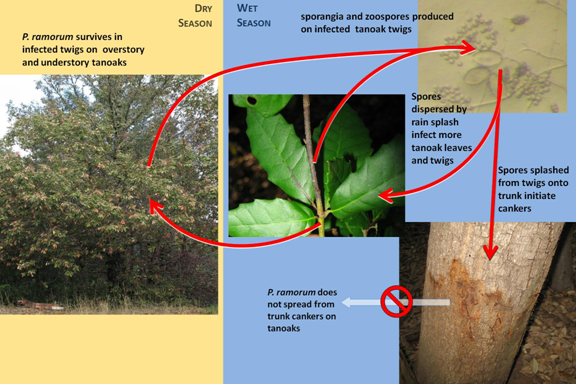
The disease cycle of P. ramorum in California differs between forests containing tanoak and those containing susceptible oaks. P. ramorum sporangia are produced abundantly on tanoak twigs (Davidson and others 2008), so inoculum produced within tanoak canopies is sufficient to initiate trunk cankers on tanoaks (fig. 1-2). Tanoaks can also be infected by spores produced on California bay (Davidson and others 2005, 2008) where these two species occur together.
In California forests that contain SOD-susceptible true oaks, infected California bay leaves typically serve as the primary source of P. ramorum spores (fig. 1-3). In oak stands that also contain tanoak, susceptible oaks can be infected by spores produced on tanoak. Because SOD-susceptible oaks are normally infected by spores produced on other hosts, different disease management strategies apply to oaks compared to tanoaks.
Phytophthora ramorum commonly infects leaves and twigs of tanoak, causing twig dieback on both mature trees and understory seedlings and saplings (fig. 1-2). Phytophthora ramorum sporangia form readily on tanoak twig cankers (Davidson and others 2008). They can be dispersed by splashing rain to other parts of the canopy, initiating additional leaf and twig infections. Spores can also be splashed from infected tanoak twigs to canopies of adjacent tanoaks, so P. ramorum can spread between trees in a tanoak stand.
Under wet conditions, as more twig cankers form in tanoak canopies, increasingly large numbers of P. ramorum spores are produced and dispersed. These spores splash onto tanoak trunks and can also move down the trunk in the rainwater that flows along the stems. These spores can initiate trunk cankers that can kill infected trees. Cankers commonly form within 1-2 meters from the ground on the trunk, but may occur higher on the trunk or on branches . Tanoak trunk cankers do not produce P. ramorum sporangia.
Various studies have shown that in California forests, SOD risk in tanoak is usually greater if California bay is nearby (Davidson and others 2008). When P. ramorum initially spreads into tanoak stands, trees located near California bay are commonly among the first to develop lethal trunk cankers. Inoculum from other host species has not been shown to be significant for causing stem infections in tanoak stands.

Figure 1-2—SOD disease cycle in tanoak stands where Phytophthora ramorum has become established. Phytophthora ramorum survives over the dry season primarily in tanoak twig infections. Sporulation occurs during the wet season primarily on infected twigs, and rain-splashed spores initiate new leaf and twig infections within the trees and on nearby tanoaks. Under prolonged wet conditions, high amounts of spores build up in the canopy and are splashed onto trunks where infections lead to canker development.